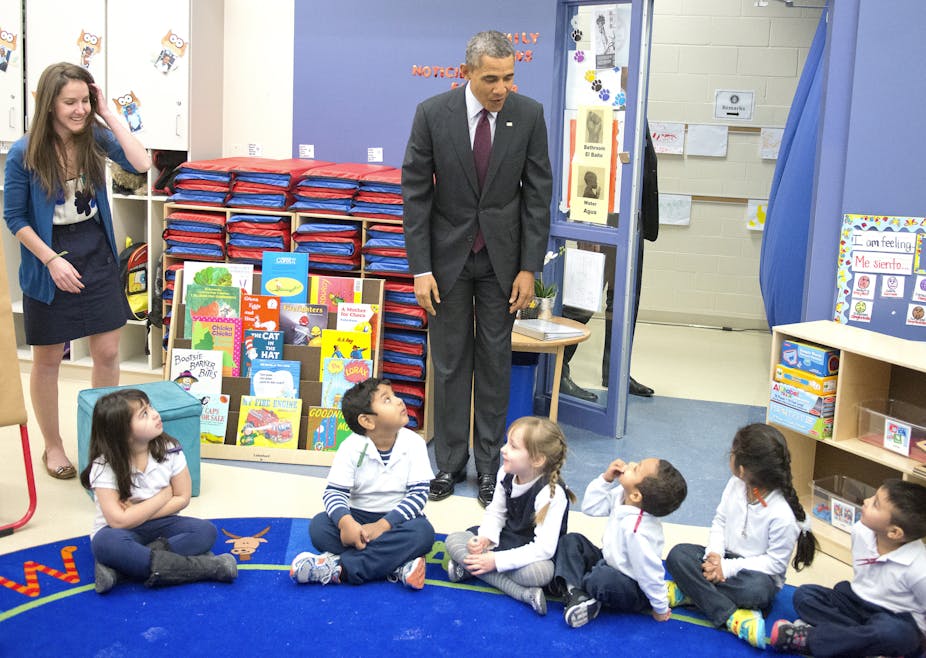“Hope and change” may have driven the first presidential campaign for Barack Obama, but many educators and public education advocates have been discouraged by Obama’s education policy.
While the US secretary of education, Arne Duncan, often claims Obama addresses education reform as the civil rights issue of our time, that rhetoric has often been contradicted by policy.
However, the recent government initiative on discipline in schools could salvage the hope that education reform can turn in the direction of better equity for all students. Based on data from the US Department of Education on civil rights, the Obama administration is calling for an end to harsh discipline policies, such as zero tolerance, that “disproportionately affect minorities”.
This introduced policies such as discipline codes that mandate expulsion or suspension for first-time offences (such as bringing a knife to school).
Two trends with disturbing parallels began in the early 1980s during the Reagan presidency: the era of mass incarceration, labelled the New Jim Crow by Michelle Alexander, and an era of public education reform that introduced high-stakes exams and accountability measures for schools and teachers.
Mass incarceration and school discipline patterns over the past three decades have disproportionately impacted African American men. African Americans are arrested and incarcerated for drug use at rates much higher than whites, even though African Americans and whites use drugs at similar rates.
White men outnumber African American men in the US about six to one, but per 100,000 people in each racial group, there are 2,207 African Americans for every 380 whites in the prison population – an inverse proportion of nearly six to one.
There are also more whites in poverty than African Americans (about 2 to 1, according to 2011-2012 data).
Incarceration inequity is a function of race, not class. As data from the Office for Civil Rights reveals, African-American students represent 18% of students in a representative sample of 85% of the US students. But they represent 35% of those suspended once, 46% of those suspended more than once, and 39% of students expelled.
Prison pipeline
As a policy that reinforces personal accountability, “zero-tolerance” resonates with the public in the US as part of a larger trust in cultural myths such as the rugged individual and meritocracy.
Kang-Brown, Trone, Fratello, and Daftary-Kapur have exposed the racially inequitable consequences of zero-tolerance policies:
There is abundant evidence that zero-tolerance policies disproportionately affect youth of colour. Nationally, black and Latino students are suspended and expelled at much higher rates than white students … And because boys are twice as likely as girls to receive these punishments, the proportion of black and Latino boys who are suspended or expelled is especially large
Based on her research in a high-poverty urban high school, Kathleen Nolan’s book Police in the Hallways forces readers to listen to the stories of young people who live under zero-tolerance policies. “In a building full of struggling and alienated students, order-maintenance policing took precedence over educative aims and a culture of control permeated the building,” she wrote.
Zero-tolerance policies were introduced to address some of the social concerns about how public schools often serve as “school-to-prison pipelines” for impoverished minority students. But by placing police in the hallways, these same policies only worked to turn those schools into virtual prisons.
The parallel inequity in the criminal justice system and in schools is repeated, however, in the academic inequity experienced by impoverished and minority students in their classrooms. Nolan details that in urban schools, there is often a predominance of high-pressure tests and controversial programs in reading and maths with “limited focus on other content areas and often none at all on art and other kinds of enrichment”.
Addressing inequity
The Office for Civil Rights highlights that gender, race and native language inequities also exist in access to advanced courses, grade retention, and teacher assignment. So for the students who need public schools the most, academics and discipline policies are apt to fail those students in ways that are discriminatory.
Zero-tolerance policies, like mass incarceration, are creating failure and criminality specifically among high-poverty African American boys.
Just as many of the current education reform commitments – such as those related to high-stakes testing, grade retention, charter schools, and Teach for America – are failing to address, and often intensifying, educational inequity, the discipline policies in US schools represent patterns that must be corrected.
Although the Obama administration appears unwilling to change course on academic reform policies, a call for addressing discipline inequities could serve as a turning point that fulfils the claim that education reform in the 21st century is the civil rights issue of our time.
But that possibility must include a larger recognition that education reform needs to address systemic racial, class, and gender inequities in society as well as institutionalised inequities reflected in and perpetuated by public schools.

